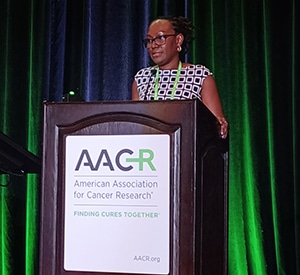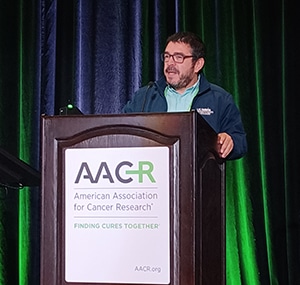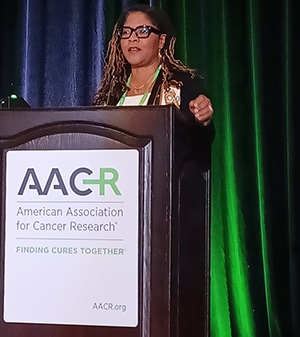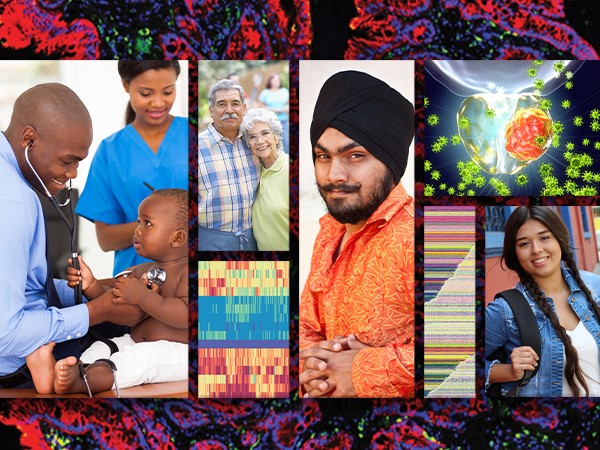The Florida Factor: Disparities Research in the Face of Anti-DEI Laws
As hundreds of cancer researchers and patient advocates traveled to Florida for the 16th AACR Conference on the Science of Cancer Health Disparities in Racial/Ethnic Minorities and the Medically Underserved, the meeting site provoked some debate.
In May, Florida Gov. Ron DeSantis signed a bill into law that prohibits the state’s colleges and universities from spending any government funds on diversity, equity, and inclusion (DEI) initiatives. The law also bans schools from teaching certain DEI-related material.
The new law had immediate effects on some of the state’s leading medical schools and universities, said Sophia George, PhD, of the Sylvester Comprehensive Cancer Center, part of the University of Miami Health System.

“The bills have negatively affected the ability to recruit faculty, medical students, and graduate students. Some schools have seen an exodus of faculty,” George said.
Florida isn’t alone; at least 22 states have introduced some anti-DEI legislation, encompassing curricula, hiring practices, college and graduate school admissions, and more. In a demonstration of solidarity and an effort to share strategies for advancing equity in the face of regressive laws, a panel of cancer center leaders led an impassioned session at the Disparities conference.
“For many years, the AACR has been at the forefront of identifying barriers and studying how to close persistent racial gaps in cancer care. We thought it appropriate to have this session discussing the impact of anti-DEI laws,” said session co-chair Renee Reams, PhD, of Florida A&M University.
The panelists expressed frustration with the onslaught of anti-DEI legislation in recent years. However, they noted that many institutions already have innovative strategies to hire diverse workforces and create programs that benefit people of every race, ethnicity, creed, sexual identity, and other diverse constituencies.
The California higher education system provides a prime example, said Luis Carvajal-Carmona, PhD, of the University of California, Davis. Since the 1996 passage of Proposition 209, California universities have been barred from considering race, sex, or ethnicity in admissions. The proposition had an immediate chilling effect on diversity, with proportions of Black and Hispanic students dropping on most campuses.
Carvajal-Carmona, the medical school’s associate vice chancellor for the Office of Academic Diversity, explained that UC Davis, along with highly selective UCs in Los Angeles and Berkeley, quickly adopted holistic admissions practices, which involve qualitative reviews of all aspects of a candidate’s application rather than relying heavily on test scores.

In the UC Davis medical school, he said, “We implemented measures to consider the life experience of candidates. We asked, ‘How will this student improve the lives of future patients?’” Over 15 years, the medical school tripled its population of Black, Hispanic, and indigenous students.
Such efforts may require continuous revision. After university leaders noticed a slight dip in representation from minority groups, they implemented the “Davis Scale,” which measured socioeconomic factors such as parental education levels and growing up in medically underserved areas. After the Davis Scale was introduced, minority representation again increased. Medical school leaders wrote about these initiatives in a recent article published in JAMA Online.
Chanita Hughes-Halbert, PhD, joined the USC Norris Comprehensive Cancer Center in 2021 in a newly created position as associate director for cancer equity. She agreed with Carvajal-Carmona’s assertions about holistic admissions, noting that those principles can be extended to faculty hiring practices.
“Our definition of diversity has really grown,” she said. “It has expanded to consider first-generation students, first-generation faculty members, and other qualities that reflect the totality of a person’s background.”
As states continue to pass anti-DEI legislation, she urged institutions to remain steadfast in their commitments to diverse, equitable practices. She said she believes the Norris Comprehensive Cancer Center is benefiting from a high standard set by the broader University of Southern California.

“Having an institutional commitment that is unwavering will help us navigate the changing national landscape,” she said.
At the University of Miami, a private institution, George knows she is somewhat shielded from the harshest effects of anti-DEI legislation. However, as the school’s first ever associate director of diversity, equity, and inclusion, she is motivated to develop a diverse workforce and programming that advances DEI principles.
To help her understand the landscape, she began digging into data. She asked the school’s human resources department to assess diversity on multiple levels: “Who had we invited to give a talk? Who had we offered positions to, who had accepted, and who was still here?” Echoing her fellow panelists, she suggested that hiring efforts could encompass more aspects of a candidate’s experience, allowing for broader perspectives even in the face of anti-DEI laws.
The panelists, who carry out their DEI positions alongside their research responsibilities, said that creative approaches can help institutions maintain strong programming and diverse workforces no matter what legislation may try to compromise their mission.
“We have to think about how we’re going to move forward despite anti-DEI laws. We need to establish inclusive environments where everyone feels that they belong,” Hughes-Halbert said.



